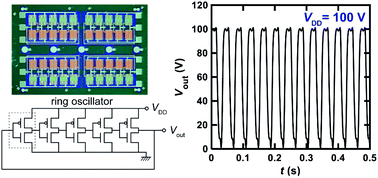Fabrication of ring oscillators using organic molecules of phenacene and perylenedicarboximide
Abstract
Organic field-effect transistors (FETs) can be applied to radio-frequency identification tags (RFIDs) and active-matrix flat-panel displays. For RFID application, a cardinal functional block is a ring oscillator using an odd number of inverters to convert DC voltage to AC. Herein, we report the properties of two ring oscillators, one formed with [6]phenacene for a p-channel FET and N,N′-dioctyl-3,4,9,10-perylenedicarboximide (PTCDI-C8) for an n-channel FET, and one formed with 3,10-ditetradecylpicene ((C14H29)2-picene) for a p-channel FET and PTCDI-C8 for an n-channel FET. The former ring oscillator provided a maximum oscillation frequency, fosc of 26 Hz, and the latter a maximum fosc of 21 Hz. The drain–drain voltage, VDD, applied to these ring oscillators was 100 V. This may be the first step towards a future practical ring oscillator using phenacene molecules. The values of field-effect mobility, μ in the p-channel [6]phenacene FET and n-channel PTCDI-C8 FET, which form the building blocks in the ring oscillator with an fosc value of 26 Hz, are 1.19 and 1.50 × 10−1 cm2 V−1 s−1, respectively, while the values in the p-channel (C14H29)2-picene FET and n-channel PTCDI-C8 FET, which form the ring oscillator with an fosc of 21 Hz, are 1.85 and 1.54 × 10−1 cm2 V−1 s−1, respectively. The μ values in the p-channel FETs are higher by one order of magnitude than those of the n-channel FET, which must be addressed to increase the value of fosc. Finally, we fabricated a ring oscillator with ZrO2 instead of parylene for the gate dielectric, which provided the low-voltage operation of the ring oscillator, in which [6]phenacene and PTCDI-C8 thin-film FETs were employed. The value of fosc obtained in the ring oscillator was 24 Hz. In this ring oscillator, the VDD value applied was limited to 20 V. The durability of the ring oscillators was also investigated, and the bias stress effect on the fosc and the amplitude of the output voltage, Vout are discussed. This successful operation of ring oscillators represents an important step towards the realization of future practical integrated logic gate circuits using phenacene molecules.



 Please wait while we load your content...
Please wait while we load your content...